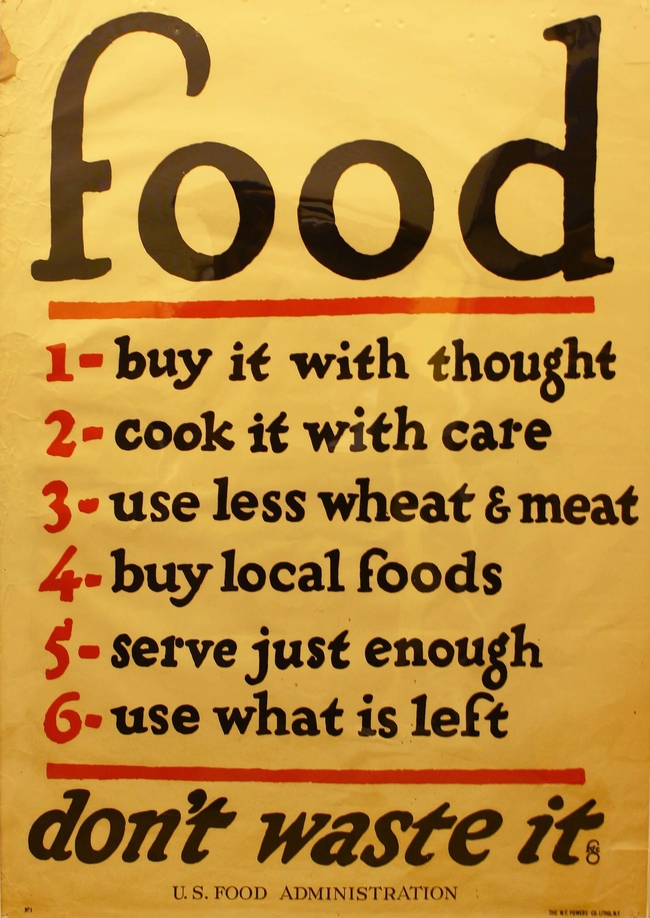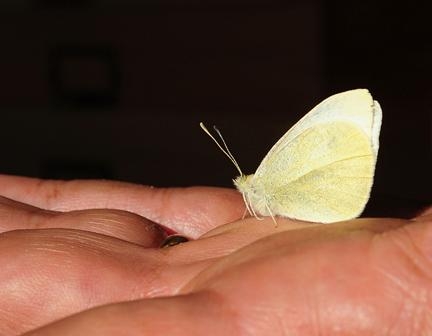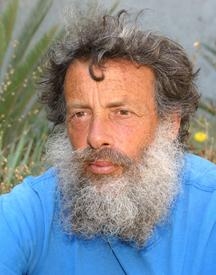Posts Tagged: art
It's time to get serious about food waste
Here's my take on food waste. It goes back in part to lessons I've learned from studying World War I, when the American government set food conservation goals (along with goals for local food production via Liberty - later Victory - Gardens). I'm a big proponent of both reducing food waste and producing more food in communities via school, home and community gardens. Big point: the World War I poster included in this post has advice we'd be well served to heed today.
"Food waste is both an ethical and environmental issue. It should concern us that we waste nearly 40 percent of the food we produce and purchase in this food-abundant nation.
For an interesting comparative statistic, consider this: our nation produced nearly 40 percent of the fruits and vegetables we consumed on the American home front during World War II in school, home, community and workplace gardens."
Period piece or photoshopped image?
It's an iconic poster from World War 1. Food...don't waste it. The image is regularly shared on Twitter and Facebook.
The original was produced in 1919 by the United States Food Administration, under the direction of the newly appointed food "czar" - Herbert Hoover.
The poster was reissued during World War II. It's been revised in recent years, by individuals and organizations interested in encouraging an ethos incorporating local foods and sustainability.
While I'm the UC Food Observer, I also dabble in the history of wartime poster art. I'm often asked if this is a contemporary mock-up made to look and feel vintage.
It's not a mock-up. It's the real deal, produced 95 years ago, with messages we should embrace today.
History of poster art
The First World War marked the first large-scale use of propaganda posters by governments. Posters, with easy-to-understand slogans and compelling images, made powerful propaganda tools. The government needed to shape public opinion, recruit soldiers, raise funds and conserve resources and mobilize citizens to important home front activities ... including gardening, food conservation and food preservation. In an era before television and widespread radio and movies, posters were a form of mass media. And they appeared in windows and were posted on walls everywhere, in as many languages as were spoken in this nation of immigrants.
If you want to dig a little deeper, the poster art of WWI was influenced by the La Belle Epoque - the beautiful era - named in retrospect, after the full horror of WWI had been revealed. The Art Nouveau movement in France and the rise of modern advertising were also important in shaping how posters were used during wartime. Technical improvements in printing, including a process called chromolithography, facilitated mass production of posters.
The original poster: Yes: 'buy local foods' is rule 4
The original poster has six rules that we'd be well served to follow today. The fourth rule - buy local foods - is somewhat of a surprise to people today, because the notion of buying local seems somewhat modern. But in WWI, the U.S. government encouraged the local production and consumption of food, in part, to free trains to more effectively ship troops and war materiel.
Tackling food waste through preservation: today's Master Food Preserver Program
UC Agriculture and Natural Resources (UC ANR) hosts a UC Master Food Preserver Program. The program teaches best practices on food safety and preservation to volunteers. The extensive training program prepares the volunteers to work in their community educating others on the safe practices of food preservation, including pickling, drying, freezing, canning and fruit preserves.
Thinking about gardening? Do we have resources for you!
UC ANR also has the UC Master Gardener Program, which fields more than 5,000 volunteers in communities across the state. The Master Gardener Program is a national program, housed at the land grant institution in each state, but it's also connected to the USDA. Free gardening resources are available here. Advice to grow by...just ask.
This is an excerpt of an article from a post on the UC Food Observer blog, used with permission.
UC Davis entomologist spots first cabbage butterfly of the season
And it all has to do with butterflies and beer.
Shapiro collected the first cabbage white butterfly of the New Year on both of Obama’s inauguration days, Jan. 20, 2009, and Jan. 21, 2013.
“The constitution mandates the swearing-in for Jan. 20, though it does not require Pieris rapae to emerge on that date,” he quipped.
“Thank you, Mr. President!”
Shapiro, a professor of evolution and ecology who has monitored the butterflies of Central California for more than three decades, sponsors his annual “Beer for a Butterfly” contest to draw attention to the first flight of the cabbage white butterfly (Pieris rapae). Since 1972, he has awarded a pitcher of beer or its equivalent to the first person collecting the first cabbage white of the New Year within the three-county area of Yolo, Sacramento and Solano.
Shapiro, who is in the field 200 days a year, has won the contest every year except for the three times his graduate students, “my fiercest competitors,” took the prize.
Will Shapiro share his beer with the President? “I'd be delighted to buy Obama a beer, but I suspect he has better things to do with his time!”
Shapiro collected both of his Inauguration Day butterflies along railroad tracks in Yolo County. This year he found the prize-winner in West Sacramento. In 2009, he netted it in Davis.
Of his 2013 find, Shapiro said: “I knew at 9 a.m. on Monday, Jan. 21, that this would be the day - the air just felt different; the sun already felt warm, although the morning low at my place (Davis) had been 32 Fahrenheit at 6:50 a.m. That was the first time in 12 mornings that it hadn't gone below freezing.”
Shapiro arrived at his West Sacramento field site at 11:30 a.m., as the temperature hovered at 59 degrees. By 1:45, the temperature would top out at 66.
Shapiro prowled around the butterfly’s host plants, including wild radish and wild mustard. “Most of the annual Brassicaceae (mustard family), and milk thistle showed frost burn.”
At 1:01 p.m. a male rapae showed up. “It was flying from east to west along the north side of the railroad tracks, just east of the I-80 overpass,” said Shapiro, who was walking along the south tracks. “Unfortunately, at the exact same moment, a fast freight was approaching from the east and I was not about to race it across the tracks! As the train roared by, the butterfly rose straight up and flew over the overpass.”
“I've known all along that the day would come when I would see the first rapae but be unable to catch it,” Shapiro said. “The protocol for such an eventuality is: I count the sight record, but keep the contest open until someone actually catches one and turns it in. I figured this would be the year I'd have to do that. But after the train passed, I milled around looking to see if it would return.”
It did. “At 1:15 it appeared out of nowhere - I think it descended vertically from above - and went directly to where it had been when I first saw it.” He caught it immediately. “It's a male of proper (post-diapause) January phenotype. I waited around until 2 p.m. but saw no more rapae -- just one Red Admiral. So, two species, two individuals for the day.”
Shapiro’s first catch of 2013 was actually on Jan. 1 at the same site, but “it was a slopover from the fall brood.” He declared the contest still under way.
Shapiro, who shares his butterfly monitoring information on his Art's Butterfly World website, holds a doctorate in entomology from Cornell University, and is a fellow of the American Association for the Advancement of Science, the Royal Entomological Society and the California Academy of Sciences. He is also the recipient of UC Davis outstanding teacher and advisor awards.
As for his graduate students, the first to defeat him in his “Beer for a Butterfly” contest was Adam Porter in 1983. Sherri Graves and Rick Van Buskirk followed in the late 1990s.
This year’s competition, however, proved especially satisfying, given that 12 days of freezing temperatures preceded the catch and it occurred again on President Obama’s Inauguration Day.
“Pieris rapae is out, and I can ‘stand down,’ said Shapiro, declaring “It’s now officially spring.”
And as for sharing a beer with President Obama, that offer still stands, too.
Slow Food group to air Sierra Valley video
The Lake Tahoe chapter of Slow Food will present the short video "Is Sustainable Attainable?" at its January meeting next week. The show is another opportunity to spread the word about a series of videos promoting the rural culture in Sierra Valley, Calif., produced as part of the UC Davis "Art of Regional Change."
The project, called "Passion for the Land: Personal Stories from the Sierra Valley," is a collection of 12 stories, told on video through narration and photos, about the challenges to agricultural viability and rural community life in Sierra Valley, according to an article in the Sierra Sun. The series was a collaborative project involving Jesikah Maria Ross of Art of Regional Change, Holly George of UC Cooperative Extension in Plumas and Sierra counties and Sierra Valley farmers and ranchers.
The "Sustainable" segment is the story of Gary Romano, who in 1990 purchased a 65-acre portion of his families' former 3,600-acre cattle ranch in Sierra Valley to establish an organic farm."I want people to understand that you don't need 5,000 acres to make a living; there is a need for farmers with 5, 10 or 60 acres," Romano was quoted in the story. "And just because the land isn't being used for farming now doesn't mean it can't be in the future. We need to preserve open space."

Gary Romano and his family on the Sierra Valley farm.



